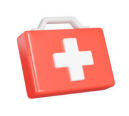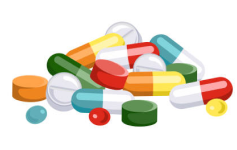SingHealth Duke-NUS Academic Medical Centre will NEVER ask you to transfer money over a call. If in doubt, call the 24/7 ScamShield helpline at 1799, or visit the ScamShield website at www.scamshield.gov.sg.
Clofazimine
Uses
What is Clofazimine for?
It is an antibiotic used for the treatment of certain mycobacterial infections. It is usually given in combination with other medications (combination therapy).
How should I take or use Clofazimine?
- Do not stop taking your medication without checking with your healthcare professional.
- This medication should be taken with food to avoid an upset stomach
- You should drink a full glass of water with each dose of this medication
- Capsule should be swallowed whole and should not be opened, unless otherwise directed
What should I do if I forget to take or use Clofazimine?
If you forget to take a dose, take it as soon as you remember. Then take your next dose at the usual time. However, if it is time for your next dose, do not double the dose, just carry on with your regular schedule. Do not take two doses to make up for the missed dose.
Precaution
What precautions should I take when taking or using Clofazimine?
Inform your healthcare professional if:
- You are allergic to this medication or any of the other ingredients of this medication, including peanuts or soya (capsule may contain soybean oil).
- You or your partner are pregnant, planning to become pregnant, or breastfeeding
- For women, use effective birth control during treatment and for at least 4 months after stopping the medication
- For men, condoms should be used during intercourse and for at least 4 months after stopping the medication
- You are taking any other medications, including supplements, traditional medications and herbal remedies
- You have a history of or current medical conditions such as heart disease, stomach or bowel problems and mood disorders such as depression
What food or medication should I avoid when I take or use Clofazimine?
This medication may cause a heart rhythm abnormality called QT prolongation. You should therefore avoid medications that may cause this side effect as much as possible. Consult your healthcare professionals for further advice
Side Effects
What are some common side effects of Clofazimine?
- Skin and eye discolouration - orange-pink to brownish black skin
- If this troubles you , please notify your doctor. After stopping the medication, it should return to normal. However, it may take several months or years for the skin discolouration to return to normal.
- Skin and eye dryness
- Apply moisturiser regularly to manage skin dryness
- Apply lubricating eye-drops or artificial tears to prevent this. Stop the use of contact lenses if irritation persists
- Discolouration (red – brownish black) of stools, lining of the eyelids, sputum, sweat, tears and urine
- Usually, this does not require medical attention.
- However, if you wear contact lenses, you may consider wearing glasses instead to prevent discolouration of your contact lenses
- Abdominal discomfort or pain, diarrhea, nausea, vomiting
- Do not drive, use machinery or do anything else that could be dangerous if you are dizzy or are not alert
- Wear protective clothing and use a sunscreen whenever you are exposed to the sun. You should avoid tanning equipment.
What are some rare but serious side effects that I need to seek medical advice immediately?
The symptoms of a drug allergy include one or more of the following:
- Swollen face/eyes/lips/tongue
- Difficulty in breathing
- Itchy skin rashes over your whole body
Some of these side effects include:
-
Liver problem
- Signs include dark urine or light coloured stools, nausea, vomiting, loss of appetite, stomach pain, yellowing of your eyes or skin
-
Gastrointestinal problem
- Prolonged or severe nausea, vomiting, diarrhoea, stomach pain; passing out bloody or blacks tools, vomiting blood or coffee-like material
- Depression (low mood) or having thoughts of harming yourself
If you experience any of these symptoms, you should stop your medication and see your healthcare professional immediately
Handling
How should I store Clofazimine?
Store in a cool and dry place, away from direct sunlight. Keep this medication away from children
How do I throw away Clofazimine safely?
Pack the medication into a bag and bring it back to the pharmacy where you received the medication from
For more information
What else should I know about Clofazimine?
There are certain restrictions in the supply of clofazimine. Clofazimine is not available in community/retail pharmacies and is only available in selected healthcare institutions via prescription from in-house doctors. Please check with your healthcare provider if they are able to supply it.
Disclaimers
Please take note that the above is not a complete list of all possible side effects. If you have any concerns about your medication or if you have other side effects that you think are caused by this medication, please consult your doctor or pharmacist.
If you take more than the recommended dose, please seek medical advice immediately. The information provided on this page does not replace information from your healthcare professional. Please consult your healthcare professional for more information.
This article is jointly developed by members of the National Medication Information workgroup. The workgroup consists of cluster partners (National Healthcare Group, National University Health System and SingHealth), community pharmacies (Guardian, Unity and Watsons) and Pharmaceutical Society of Singapore. The content does not reflect drug availability and supply information in pharmacies and healthcare institutions. You are advised to check with the respective institutions for such information.
Last updated on April 2024

Need More Medicine?
Use Medicine Order Service on HealthBuddy.

Medicines Reminder
Get reminders and chart progress on HealthBuddy.
© 2025 SingHealth Group. All Rights Reserved.
















































